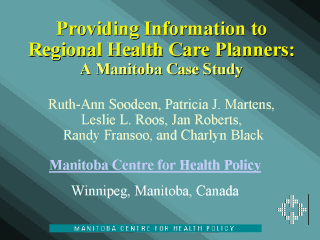| front |1 |2 |3 |4 |5 |6 |7
|8 |9 |10 |11 |12 |13 |14 |15 |16 |17 |18 |19 |20 |21 |22 |23 |review |
 |
In an era of
fiscal constraints,
regionalization
of health care has been viewed as an appropriate strategy in systems having national
health insurance. Local planners face unprecedented information needs in trying to
understand the health status of their populations and to support decisions about how best
to deliver health services to the citizens they serve. Ideally, this ‘knowledge’ must
incorporate good research evidence about the health needs of their populations. Kouri, Dutchak, and Lewis (1997)1 note that in order to fully understand regionalization, it is “essential to gather data - preferably longitudinal - in a number of jurisdictions.” Provincial administrative databases available in Canada provide particularly relevant information. Using Manitoba as a case example, this lecture describes how administrative data can help inform the decision-making process at the local level. |